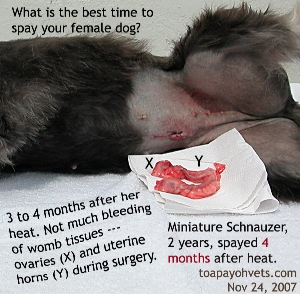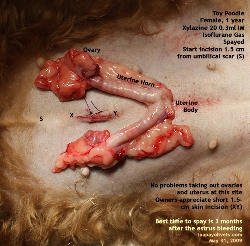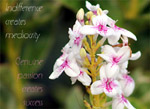AIR-CONDITION FOR
A CHOW CHOW AFTER SPAY?
Dr
Sing Kong Yuen, BVMS (Glasgow), MRCVS
First written: 3 Oct 2007
Updated:
17 July, 2010 |
 toapayohvets.com toapayohvets.com
Be Kind To Pets
Veterinary Education
Project 2010-0129 |
|
|
Wednesday, July 14,
2010 inspection
Dusk fell fast in July. The waiting room was pitch dark
as Mr Saw, my assistant was at the back feeding the dogs while
Ms Lai, the intern had just gone for her dinner. I was in the
consultation room typing up my ear canal resection
observations for my record and experience.
Procrastination means never recording them as every day seems to
fly by so fast and there are so many tasks to accomplish.
I noticed a young lady in black spectacle frames coming
into the waiting area at around 6.30 pm on July 14, 2010 as my
consultation room door has a glass window on the top
half.
I thought she was going to pick up her dog, cat or
hamster as my associate Dr Teo has several in-patients.
3 cat fight wounds and 3 other dogs and two hamsters. I
had three ear canal resection cases - a Cavalier King
Charles and two Cocker Spaniels. I had a motorbike abrasion
trauma case of a French Bulldog whose owner requested
hospitalisation for 2 days. Also 4 hamsters from a young
man and two young
rabbits from a middle-aged lady who sneezed every time
she was near the rabbit and so they were kept in the
Surgery looking for new homes. The kennels at Toa Payoh
Vets was full house today.
The young lady waited. So, I left my computer to speak to her.
"I have an appointment to check out the Surgery. I have
made an appointment for my dog to
be spayed on Sunday," This was the first time I get an
inspection from a prospective dog owner since I started
practice in 1982. Well, there is nothing to hide and so
I showed her the small practice.
After that, she asked questions. I took out two
post-cards to scribble the questions so that I can
publish them here for the benefit of dog
owners and for my knowledge management archives. She
asked to keep my writing on my two post cards but they
were full of scribbles. I promised to e-mail to her the
replies to worries in her mind. My replies are
given below for all readers they are FAQ (frequently
asked questions):
Thursday, July 14,
2010
Dear Ms ....
SPAYING THE CHOW CHOW
1. No food and water 10 hours before arrival at the
Surgery.
2. Your Chow Chow may arrive at 12 noon on Sunday and
surgery will be performed around 1-2 hours later
depending on my caseload.
3. Bathe your dog before coming to the Surgery and check
that she has no skin disease on her belly area.
4. She should be active and has had normal appetite on
Saturday. If she has vomiting, diarrhoea, loss of
appetite or is inactive, do not bring her for spay. Let
us know should you cancel the appointment.
5. At the Surgery, I will examine her. If she has no
fever or heart problems, spaying will be done by me.
6. Her belly hair will be clipped. Then she goes to Operation
Room. Surgery takes around 15 minutes.
7. Anaesthesia for your Chow Chow will be
pre-anaesthetic dose of Domitor IV and Isoflurane gas
maintenance.
8. An IV saline drip will be set up.
9. An antidote to Domitor called Antisedan will be
injected post-operation. This injection wakes up the dog
in a few seconds as if from a short nap.
10. Post-op tolfedine painkillers and baytril antibiotic injection
will be given.
11. The dog can go home 2 hours later with antibiotics
and tolfedine pain-killers for the next 4 days. We will
phone you to take the dog back.
12. For the first 2 days, the dog may or may not be
active or eating much. It will be good if you take leave
on Monday. If not, ensure that the dog is crated or in a
small room.
13. Check the surgical area daily for pus or abnormal
bleeding. Replace the plaster 2 days later after using a
piece of facial cotton with clean warm water to wash
away the blood clots. Dry the wound after washing. Then
put on the new plaster.
14. No e-collar will be used in your dog although I do
recommend in many female dogs. Your Chow Chow may not
like it.
15.
The plaster protects the wound from being dirtied. Usually the dog
does not lick the wound if the painkillers are given
as instructed. Some owners are unable to give the
tablets directly onto the back of the tongue, close the
mouth, stroke the neck while lifting up the head. Some
dogs are too smart and just spit out the tablets and
therefore do not get the pain-killing effect. They start
to lick the operation wound.
16.
Therefore, an alternative method is to conceal the
tablets in cheese or meat balls. The first two balls
given will not contain the drug. The third will contain
the drug. Delay the meal time by one hour as an example.
Usually the dog just swallow her favourite food
quickly as she will be desperately hungry.
17. The absorbable skin stitches will dissolve in 21
-28 days. So you need not come for stitch removal
unless you want to get the stitches removed in 14 days
as some dogs do get irritated by the stitches. Stitch
abscesses form and are irritating. Observe daily and
you can use clean scissors to cut off the knots on Day
14. Usually I stitch 2 skin stitches and they can be cut
off easily 14 days after surgery.
18. If possible don't let the dog walk up and down
slopes or stairs in the first 7 days. As the wound is
around 2
cm long (if there are no complications), this will not be
a big problem with stitch breakdown. However, try not to
let the dog jump and run around as she will feel active
by Day 2 as the painkillers mask the pain.

Best Time to Spay Your Female Dog |
QUESTIONS THE OWNER
ASKED:
1. Bathe the dog? Yes, but make sure the plaster is not wet.
2. Can the dog eat any food? Yes.
3. When to come back to remove the stitches. No need. The absorbable
stitches will dissolve and fall off in 14-28 days.
4. When to remove plaster? 7 days later.
5. Can give antibiotic and pain-killer tablets be crushed and mixed
with water and put inside a syringe to give to the dog? Yes.
|
 |
Dog spayed by Dr Sing.
An almost blood-less spay because
the female dog was spayed 2-3 months after the heat. |
19. Air-condition post-operation for the Chow Chow
with her thick coat. In my experience, the body
temperature after surgery drops due to the sedation and
anaesthetic. No air condition is necessary. No
Alaskan malamute, Siberian Huskies or Chow Chow have
suffered from heat stress due to the lack of air
conditioning post-operation in my Surgery. In your case, the dog goes
home two hours post-operation and therefore she should
be OK with you.
20. During the past 20 years of practice, I seldom get post-operation
infections and complications after the spay if the owner
nurses the dog well. Some 10-15 years ago, I did not
give pain-killers post-surgery and the dog might howl in
pain at home and during the first night. With
pain-killers and antibiotics properly taken, no spayed
dog should cry at home within the first 24 hours after spay.
I hope all the questions are answered. E-mail your
questions if you have more queries. Best wishes. |
She replied on July 15, 2010:
Dear Dr Sing
Thank you for the comprehensive reply. See you on Sunday!
Warmest regards,
|
|
|
 More info at:
Dogs or
Cats More info at:
Dogs or
Cats
To make an appointment: e-mail
judy@toapayohvets.com
tel: +65 9668-6469, 6254-3326 |
 toapayohvets.com toapayohvets.com
Be Kind To Pets
Veterinary Education
Project 2010-0129 |
|
|
 Toa
Payoh Vets Toa
Payoh Vets
Clinical Research
|
|
|
Copyright ©
Asiahomes Internet
All rights reserved. Revised: July 17, 2010
Toa Payoh Vets |
|
 TOA
PAYOH VETS
TOA
PAYOH VETS TOA
PAYOH VETS
TOA
PAYOH VETS